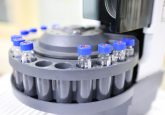Cranking up the plate count – the most obvious way

In this installment of Robert MacNeill’s (Envigo) column, Robert discusses how to increase column plate count.
Robert MacNeill received his Bachelor’s degree with Honors in Chemistry from Heriot Watt University then his MSc in Analytical Chemistry from the University of Huddersfield, both in the United Kingdom. Robert is also a Chartered Chemist and a Fellow of the Royal Society of Chemistry. With 20 years of experience in all aspects of quantitative bioanalytical LC–MS/MS method development, 11 of these years heading method development activities within HLS/Envigo, and a regular author and peer reviewer for the journal Bioanalysis, Robert is a recognized expert and innovator in the field.
This piece is not focused on chiral LC–MS, but it is a convenient avenue to the topic I’d like to bring up. In my 21 years in the CRO environment, I have seen my fair share of chiral LC–MS methods. Within these methods, the chiral columns typically have had a length of 100 to 150 mm, which I believe is reflective of the industry standard for quantitative LC–MS application. This is a lot longer than the 30 – 50 mm commonly used in regular achiral small molecule bioanalysis. In chiral LC, where sub-3 micron technology is not available to add to the plate count, this length is necessitated by the requirement to baseline separate at least two key components (at least one enantiomeric pair) in the extract being injected. It may seem somewhat speculative, but attaining adequate ruggedness of chiral methods has been, in my experience, frequently easier to come by than for achiral. I don’t think it’s a huge leap to suppose that the extra plates in the length have an impact that helps lead to this outcome. It’s just accompanied by a sacrifice of a longer run time, and signal-to-noise since there will be more peak broadening in the longer migration to the column outlet, in essence a trade-off between these two aspects and the more rugged performance.
This article is part of Robert MacNeill’s (Envigo) quarterly column for Bioanalysis Zone. You can read past installments of the column here.
A key factor, we can pretty safely reckon, is that the aforementioned increase in column plate count is affording better discriminating power with regard to the interferences present. In the same vein, there are plenty of methodologies that employ an oversized column, as it were, to shore up the overall selectivity after a crude sample extraction procedure. This counts where particle size and superficially porous particle technology, directly affecting pore length and mass transfer, are either exhausted or not an option. In these instances of crude sample preparation procedures, it is usually deproteinization of plasma or serum samples via the addition of organic solvent. As implied by the term, all that is being removed from the sample is protein matter, and even then it is by no means eliminated. Far more significantly for LC–MS, the entire lipid content remains, along with a plethora of peptide matter and salts. Within the lipid content, it is phospholipids for which these methods are typically set up to attain selectivity for using the chromatography. Phospholipids, specifically phosphatidylcholines and lysophosphatidylcholines, are very well characterized in quantitative bioanalysis and are directly monitored in method development. A longer column aids in resolution from the envelope of lysophosphatidylcholines in particular, since these have a strong tendency to elute within the retention windows of a great many small molecules in optimized methods. Phosphatidylcholines, with their very pronounced hydrophobicity, are retained much more, and in this context a larger column actually exacerbates the problem of eluting these inside a reasonable run time. If allowed to accumulate over many injections, the risk is there of signal drift and all its negative implications. In the vast majority of cases, though, setting the last segment of the run to a mobile phase composition of >98% methanol will bring off these key interferences within a handful of minutes, and direct monitoring in method development will give exact timings.
The longer the column, and especially if it has a greater internal diameter, the more difficult and important it becomes to ensure complete elution of lipophilic interferences. This, amongst one or two other considerations, brings me to one of the greatest frustrations I feel upon reading so many methods reported in the literature that feature humongous columns, in the quantitative LC–MS context, regularly in the order of 250 x 4.6 mm. The frustration arises from the analyte retention characteristics being inescapably inadequate in these methods. As chromatographers, we ought to know that we need 3 void times to pass before our analytes elute. That is part of the essence of the retention factor formula for isocratic systems, and the acceptable window of 2 to 10 for retention factor values. In the case of a 250 x 4.6 mm column with a 1 mL/min flow rate, the void time is 2.5 minutes thus we are looking for a 7.5 minute starting line for retention times. These methods I am referring to, however, have analyte elution usually right after the void time (2.5 minutes), sometimes up to 2 void times (5 minutes), and the total run time is a seemingly convenient 5 or 6 minutes. It can often be even more deceptive when resolution between two analytes is apparent, but it’s not chromatography with integrity. The retention is woefully inadequate, and the process is more akin to filtration rather than chromatography. There are a number of dangers of eluting too close to the void, then there is also the danger of interferences accumulating as a result of lack of proper optimization especially on the larger dimensions. So, on the whole, we need to preserve chromatographic integrity, and that does not depend on what column dimensions we work with.
It is all very well to deviate from the ‘norm’ and select a column of what might be seen as unusual dimensions as part of ensuring decent selectivity in a method as a whole. We just need to be sure to maintain awareness of the implications that accompany such decisions. It is pivotal to work by the rudimentary requirements of chromatography, principally gauging what is unacceptable and acceptable retention. Also, in the broader picture, setting a suitable balance between chromatographic run time and overall resolving power, figuring the sample extraction into the decision process. The most rugged methods, when required and as is synonymous with the regulated laboratory, would involve both highly selective extractions and chromatography with emphatic resolving power.






